STEP #8 CLOSING THE SALE: クロージング時の問題は?
Closing the sale should address three problems. They are price, terms of payment and why buy now. It is putting in writing what you have verbally already agreed on.
If the salesman has done a good job in all of the other steps up to this point, closing should be very easy. If the sales person has done a good job in building value in the product, the customer will buy.
営業の責任は
It is the responsibility of the salesman to (1) complete a purchase order and ask a closing question, (2) determine any objections, (3) ask the customer if he will buy if those objections are solved, and (4) get a signed counter-offer from the customer. A salesman in a truck or car dealership is only an agent for the dealership, and he should not refuse any offer, as he does not own the vehicle himself.
ディスカウントが必要な場合は
If you must discount and negotiate with a customer, (1) Start high, (2) justify the price, (3) come down slowly, (4) always give a reason for coming down, (5) not lower your price until the customer raises his, (6) continue to sell value, (7) make the negotiation fun and interesting.
顧客のタイプを見極める
While negotiating with the customer and using many different closing techniques, the salesman should determine if the customer is a quick deciding person or a person who likes to take his time and gather a lot of information and opinions. If he knows that, he will know how fast or slow to go with the customer.
Ronさんの交渉テクニックの一つ
I enjoy presenting the product much more that negotiating price, but just for the fun of it, here is one closing technique. It is called “Reduction to the Ridiculous Close”. Here are the steps:
1. If the customer says the price is still too high after asking for the sales several times, ask the customer what he expects to pay.
2. Subtract the sales price given from what he expects to pay.
3. Then ask the customer how many years he plans to use the product. (For a vehicle, this can be as long as he has kept his current vehicle.)
4. Divide the difference between what he planned on paying and what the selling price is (#2) by the number of years he plans to use the product (#3).
5. Divide #4 above by 365 days. This is the extra cost of buying the vehicle on a daily basis. It is usually just a few cents.
6. Ask the customer to buy the product, as he is only paying a few cents a day for all of the benefits of the new product which he did not know before he received a detailed presentation from you.
If the customer still hesitates to buy the product, he may be a person who needs to think the purchase through for a while or a person who wants to gather more information for a while and decide slowly. Some people gather information in public in front of people. They make decisions when alone. Other people gather information and study alone and decide in public in front of the salesman. The salesman should consider what type the customer is.
Other than that, the salesman may have made a mistake in qualifying the customer, selecting the right product or presenting the features of the product.
Ronさんのセミナーいかがですか。苦労の多かったRon-sanの青春時代やキャリア形成の話、来日後、特に、いすゞ自動車勤務でのカルチャーショックとグローバルリーダーとしての活躍など。それとRonさんが楽しみにしている出席者と皆さんとのノミュニケーション。
皆さんがおやりになっている勉強会などに出張し講演させていただきます。本人の希望は、英語での発表です。
ただし、Ronさんが住んでいる東京都大田区から日帰りできるところとさせてください。
もっとも台湾でも日帰りは可能ですが。
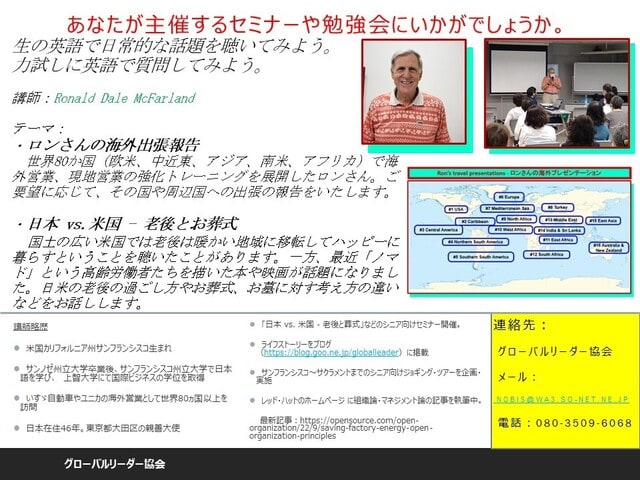
<仕事に疲れたら『武蔵野』でコトリップ(『武蔵野』リイド社、斎藤潤一郎著)>
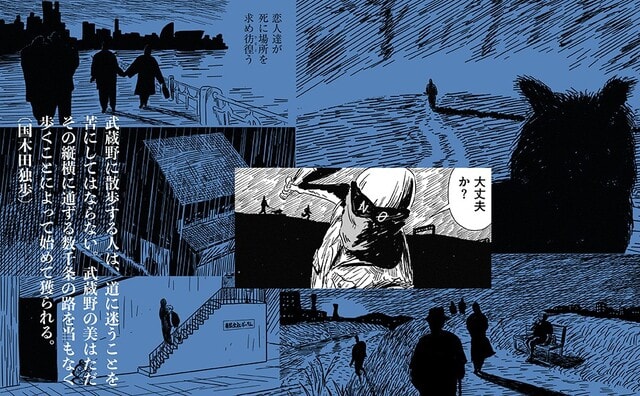
Closing the sale should address three problems. They are price, terms of payment and why buy now. It is putting in writing what you have verbally already agreed on.
If the salesman has done a good job in all of the other steps up to this point, closing should be very easy. If the sales person has done a good job in building value in the product, the customer will buy.
営業の責任は
It is the responsibility of the salesman to (1) complete a purchase order and ask a closing question, (2) determine any objections, (3) ask the customer if he will buy if those objections are solved, and (4) get a signed counter-offer from the customer. A salesman in a truck or car dealership is only an agent for the dealership, and he should not refuse any offer, as he does not own the vehicle himself.
ディスカウントが必要な場合は
If you must discount and negotiate with a customer, (1) Start high, (2) justify the price, (3) come down slowly, (4) always give a reason for coming down, (5) not lower your price until the customer raises his, (6) continue to sell value, (7) make the negotiation fun and interesting.
顧客のタイプを見極める
While negotiating with the customer and using many different closing techniques, the salesman should determine if the customer is a quick deciding person or a person who likes to take his time and gather a lot of information and opinions. If he knows that, he will know how fast or slow to go with the customer.
Ronさんの交渉テクニックの一つ
I enjoy presenting the product much more that negotiating price, but just for the fun of it, here is one closing technique. It is called “Reduction to the Ridiculous Close”. Here are the steps:
1. If the customer says the price is still too high after asking for the sales several times, ask the customer what he expects to pay.
2. Subtract the sales price given from what he expects to pay.
3. Then ask the customer how many years he plans to use the product. (For a vehicle, this can be as long as he has kept his current vehicle.)
4. Divide the difference between what he planned on paying and what the selling price is (#2) by the number of years he plans to use the product (#3).
5. Divide #4 above by 365 days. This is the extra cost of buying the vehicle on a daily basis. It is usually just a few cents.
6. Ask the customer to buy the product, as he is only paying a few cents a day for all of the benefits of the new product which he did not know before he received a detailed presentation from you.
If the customer still hesitates to buy the product, he may be a person who needs to think the purchase through for a while or a person who wants to gather more information for a while and decide slowly. Some people gather information in public in front of people. They make decisions when alone. Other people gather information and study alone and decide in public in front of the salesman. The salesman should consider what type the customer is.
Other than that, the salesman may have made a mistake in qualifying the customer, selecting the right product or presenting the features of the product.
Ronさんのセミナーいかがですか。苦労の多かったRon-sanの青春時代やキャリア形成の話、来日後、特に、いすゞ自動車勤務でのカルチャーショックとグローバルリーダーとしての活躍など。それとRonさんが楽しみにしている出席者と皆さんとのノミュニケーション。
皆さんがおやりになっている勉強会などに出張し講演させていただきます。本人の希望は、英語での発表です。
ただし、Ronさんが住んでいる東京都大田区から日帰りできるところとさせてください。
もっとも台湾でも日帰りは可能ですが。

<仕事に疲れたら『武蔵野』でコトリップ(『武蔵野』リイド社、斎藤潤一郎著)>

















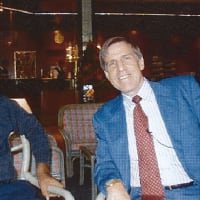
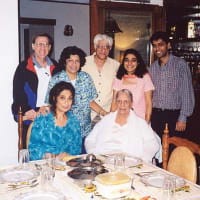
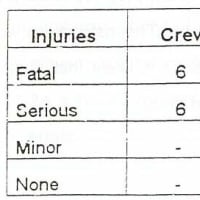

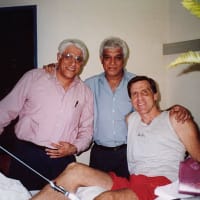
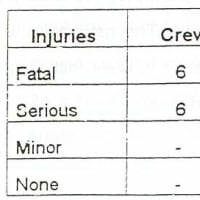






※コメント投稿者のブログIDはブログ作成者のみに通知されます